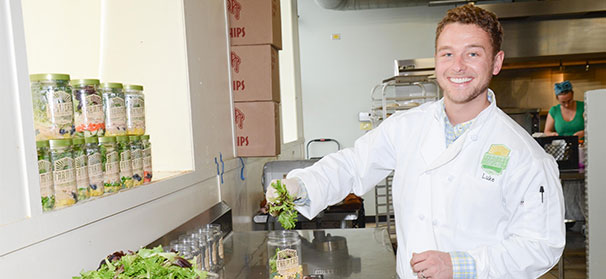

Apr 17, 2014Micro markets take produce sales to the next level
Next year marks Vic Pemberton’s 30th year in the vending business.
And he’s the first to say that three decades ago, he never would have predicted the revolution that’s happening in the industry today.
Owner of several companies based in Dothan, Ala., operating under the Pepi’s brand – including Pepi’s Vending and Pepi’s Markets – Pemberton is stocking about 225 total units: vending machines, a newer vending concept called micro markets and a hospital-based café and coffee shop in parts of Alabama, Florida and Georgia. He’s stocking the units with fresh foods that include fresh-cut products: salads, apples and dip snacks, parfaits with fresh berries and cut veggies with dressing.
The company built a new 5,000-square-foot commissary to produce the fresh offerings, working with a foodservice provider to source the greens, lettuces and other vegetables and fruits. The items are assembled at the commissary and then trucked to the various locations.
“We don’t get a head of lettuce anymore and cut it up,” Pemberton said. “We get it chopped. Carrots? We get them cut. It’s the convenience aspect of pre-washed and precut vegetables and fruit.”
And the availability and quality of fresh-cut produce couldn’t come at a better time for the vending industry. According to Dan Mathews, executive vice president and COO of the National Automatic Merchandising Association (NAMA), which has about 1,800 member companies, micro markets like those Pemberton operates are the new frontier in vending. He estimated there are at least 5,000 nationally – and growing fast. Typically located in a room inside “closed environments” like business and industrial settings, they operate on a self-service model with customers checking themselves out to pay for what they purchase.
“They are like a mini retail store,” Mathews said. “People go in and make their selections, they do a bar code (to check out via a cashless payment system) and off they go.”
And fresh fruits, vegetables and salads play no small part in their skyrocketing success. Because space isn’t as limited as it is in a traditional vending machine, providers can offer more variety. Customers can also see and touch the packaging – another plus.
Jim Brinton, who has owned Evergreen Vending based in Washington state for 38 years, has been a pioneer in micro markets through his Avanti Markets company. In fact, he’s the largest micro market operator in the country, with him and his licensees operating about 2,500 locations throughout the United States.
A former chairman of NAMA, Brinton said micro markets are a logical direction for a vending industry that was seeing traditional sales falling.
“We were watching sales slide and profits slide,” Brinton said. “Customers were asking for something different, and we were still doing pretty much the same things we were doing 38 years ago.”
What they were asking for, he said, was healthier choices. And while Brinton offers a limited selection of fruit and vegetable snacks and salads in vending machines, the options are much greater in the micro market setting, which also benefits from the customer’s ability to examine the product in hand before the purchase.
Going to the micro market concept a few years ago meant revamping his warehouse to create more refrigeration for all of the fresh and fresh-cut produce offerings, in addition to sandwiches, yogurts, cheeses and the like. Brinton doesn’t do any processing or assembly, instead sourcing from multiple fresh-cut providers including some major name brands for the produce snacks and salads he sells.
And maintaining freshness with minimum waste is one of the biggest challenges.
“Scheduling is really important,” he said.
So is gauging supply and demand, which can be fickle and dependent on factors as simple as weather – in bad weather, people may be more likely to stay inside and source the micro market, as opposed to wanting to get outdoors and go somewhere else on nicer days.
Advancements in fresh-cut processing only help the micro market model when it comes to fresh-cut snacks and salads.
“The industry has done an excellent job of prolonging the shelf lives of those items,” Brinton said.
Micro markets will continue to multiply, Brinton said, estimating that they’ll increase by 3,000 to 5,000 units annually for the next several years.
“I believe that 30 percent of the total current or previous vending locations will end up becoming a micro market location in the near future,” Brinton said. “And that will represent approximately 60 percent of gross income for the industry.”
And whether vending or micro market, it’s still all about convenience – with a strong focus on quality.
“We’re building a model where we get it in today, package it and have it in the cooler or vendor tomorrow,” Pemberton said. “On average, it sells within two or three days. Other than me going into the field and picking it, we can’t get it any quicker.
“It’s the hot new thing. And we’re excited about it.”
– Kathy Gibbons














